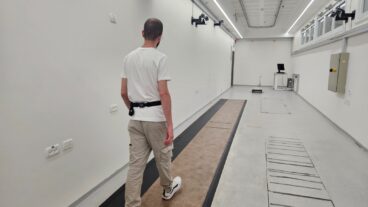The Elbit joint helmet mounted cueing systems, known as JHMCS, ‘has changed the nature of fighter-aircraft combat.’U.S. Army fighter pilots will soon be wearing an Israeli-made helmet that allows them to to lock a missile onto an enemy target aircraft simply by looking at it.
Vision Systems International, a subsidiary of Elbit has been awarded a $60.1 million contract from Boeing for the delivery of the 300 joint helmet mounted cueing systems, known as JHMCS.
This is the largest order ever gotten for the technology pioneered by the company. The systems, which cost about $200,000 each, are three-quarters of a $81.2m. helmet system contract awarded by the Pentagon to Boeing in February. The helmets are expected to be supplied within 18 months.
With a display panel of the plane’s main indicators projected onto the helmet’s visor, the helmet allows pilots to keep their heads up while flying.
When a pilot can view critical flight and combat data projected onto the inside of their visors, he no longer has to look down at his cockpit instruments to lock on sensors or weapons to targets. His magnetic head tracking unit further allows the pilot to lock on an enemy target without maneuvering the entire plane into position, which saves critical minutes.
This technology increases situational awareness and gives pilots a critical advantage in dogfights. Elbit claims that the sights, when used in conjunction with ultra-modern fourth generation air to air missiles, give a pilot a 90% chance of winning a dogfight, while his rival only has a 10% chance of victory.
“This helmet system has changed the nature of fighter-aircraft combat. A fighter pilot can aim and fire an air-to-air-missile, such as an AIM-9X, at a high angle without repositioning his plane to face the target,” said Steve Rodan, director of the Montreal-based Middle East Newsline, a daily news agency that specializes in Middle East security and defense.
The helmet’s functions will also have night-time capability when integrated with panoramic night vision goggles.
According to Rodan, the U.S. Air Force feels comfortable with the Elbit-Boeing relationship.
“The U.S. Air Force has preferred Elbit Systems technology because it has been a pioneer in the field of helmet-mounted cueing systems. Other
companies are trying to come up with competing products, but right now it appears the Elbit systems continue to lead the pack. Elbit’s partnership with Boeing is a major reason for U.S. Air Force confidence in the system,” he said.
Ken Stansell, President of VSI , said that Boeing’s choice of their product “is a testament to the revolutionary capabilities the helmet provides fighter planes. This latest contract from Boeing further reinforces VSI’s leadership in advanced helmet mounted cueing systems.”
According to financial analysts Lehman Brothers, this award is only the beginning of contracts that VSI can expect to receive in the near future.
“In March we issued a report in which we predicted VSI to win 60% of that order so this is certainly good news for VSI,” Tobias Fischbein, an analyst with Lehman Brothers in London told The Jerusalem Post. “This is a low rate first production order,” he added. “Boeing expects a full-rate production award from the Pentagon in June for 1,500 systems for a total value of $300m. That contract is expected to be supplied over a number of years.”
VSI, which was formed in 1996, is a joint venture of Elbit and Kaiser Electronics which was later bought out by Rockwell Collins. The company is a principle subcontractor to Boeing and supplies the helmets’ system components. Boeing, in turn, integrates the helmet systems for the US Army and Air Force.
Elbit has already sold the helmets to the Norwegian Air force for its F-16s, to South Korea’s Air Force for its F-15K’s, and to the Greek and Israeli Air Forces. Besides the JHMCS, VSI is in development of the “DASH” helmet system for Lockheed Martin and of a helmet system for the F-35.
In another important development for Israeli military aviation technology, the Israeli airborne system designed to divert missiles fired at civilian passenger airplanes, has been presented to Israel’s Civil Aviation Authority, Ha’aretz reported last week. The system created by Israel Aircraft Industries and Israel Military Industries, and is awaiting certification by the Israel Airports Authority, is slated for use by the national carrier, El Al, and Arkia.
The development of the system was accelerated in the wake of the attempt in November last year to bring down an Israeli passenger jet taking off from Mombasa, Kenya, with two shoulder-launched missiles. The operational demands of the system, as laid out by the government and Civil Aviation Authority, will provide an answer to the threat of missile attacks during takeoff and landing. In addition, the decoy system was required to have a range of hundreds of meters.
Until now, such decoy systems have been developed only to provide protection for fighter aircraft. IMI developed the Tactical Air-Launched Decoy (TALD) system, which is used by the Israel Air Force and the fighter planes of the U.S. Navy currently in operation in Iraq. The primary innovation in the new system is that it provides protection for civilian aircraft during takeoffs and landings, deemed the most vulnerable stages of flight.
According to Ha’aretz, the new system is already in use in two executive 707 Boeings owned by two heads of state in in Asia and Africa. Industry sources say the Israeli system is the only available one of its kind at present. The sources add that once the system is purchased by the Israeli airlines, foreign carriers will be quick to follow.












